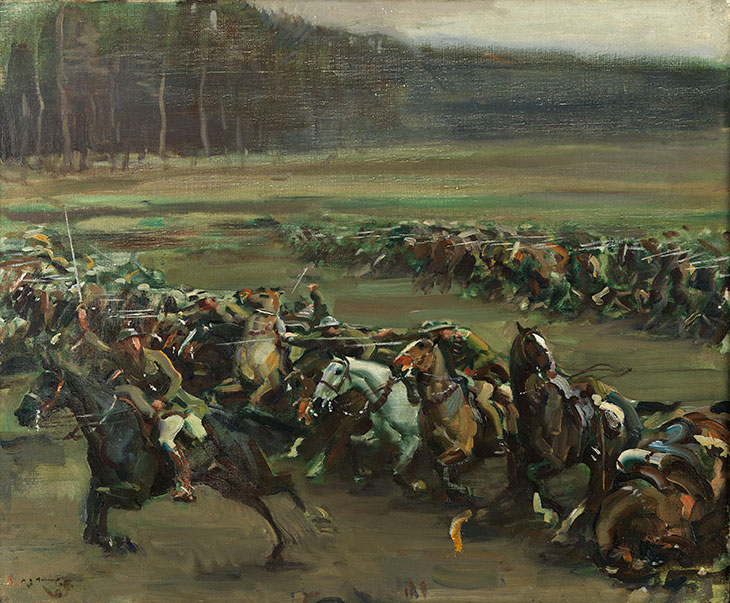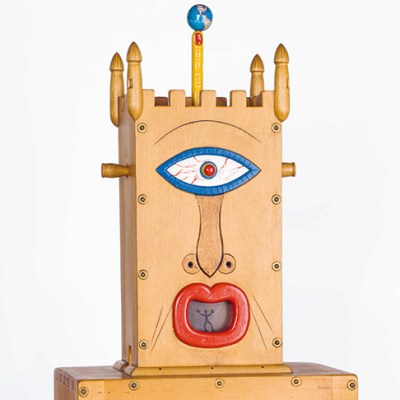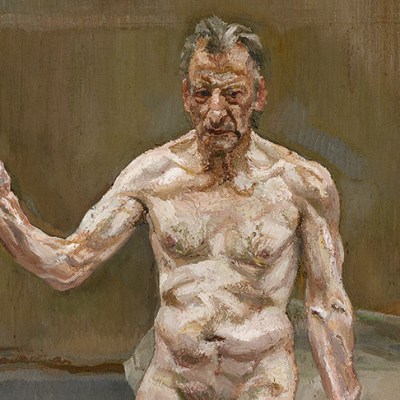The French royal portrayed in Alfred Munnings’ Captain Prince Antoine of Orléans and Braganza (1918) sits proudly on his steed, framed by a sunlit classical façade. A passing glance might just miss the flash of green at the horse’s shoulder, echoed in flickers along the flank and again in notes of blue across the neck. These notes are a revelation typical of Munnings’ work, in which the naturalism perceived from afar is apt to diffuse into an impressionistic mirage of painterly daubs and flecks.
The unexpected fusion of colour in this painting was mentioned by the artist William Orpen in his account of Munnings’ plein-air painting methods, which was quoted in the Morning Post. Munnings wrote a letter in response, which was also printed in the paper, recalling how ‘Lieut.-Col. Geoffrey Brook […] came up behind me and watched me painting green lights on the horse’s flanks. Nothing would make him see or believe they were green.’ Munnings then ‘called to Orpen’, who was nearby, to settle the dispute; after looking ‘for a brief moment’ at the horse Orpen agreed wholeheartedly with Munnings’ assessment.
Captain Prince Antoine of Orleans and Braganza (1918), Alfred Munnings. © Beaverbrook Collection of War Art, Canadian War Museum

The incident encapsulates much of what was unusual about Munnings’ assignment as an official war artist with the Canadian Cavalry Brigade in January 1918. He was one of several artists commissioned by the Canadian War Memorials Fund under the instruction of Sir Max Aitken, later Lord Beaverbrook, to publicise Canada’s contributions to the Western Front. Perhaps hoping to give weight to the cause, Beaverbrook intentionally chose painters rather than photographers.
The results, abandoning the conventions of documentary-style black-and-white images of conflict, offer a glimpse of soldiers’ daily life through the sensitive eye of a little-known East Anglian artist who favoured startling light effects and loose brushwork and was fascinated by equine anatomy. Munnings later remarked that ‘the war made one work; but what a chance for an artist! Day after day with all the models I needed.’ Forty-one paintings (out of a total of 45 purchased by the Canadian government soon after the war) are on loan from the Canadian War Museum in Ottawa in the current exhibition at the Munnings Art Museum in the artist’s own former residence, Castle House in Essex, after a first stop at the National Army Museum in London. Here they have been reunited for the first time with the surviving sketches on which they were based.
Charge of Flowerdew’s Squadron (1918), Alfred Munnings. © Beaverbrook Collection of War Art, Canadian War Museum

Most of the scenes are surprisingly pastoral, with the exception of Charge of Flowerdew’s Squadron (1918), depicting an attack against the Germans at Moreuil Wood on 30 March 1918 in which most of the 75-man Canadian squadron died. The moment is captured entirely from Munnings’ imagination, and though he was deft at infusing drama – the scene is displayed beside Fire on the Prairie, an equally energetic drawing from as early as 1890 – there are almost no visible casualties and the occasion seems somewhat glorified; the exhibition catalogue refers to it as a ‘gallant charge’.
Other more observational works hold greater appeal for a contemporary audience. Taking full advantage of the wealth of the permanent collection at Castle House, the museum has included playful cartoons of officers off-duty and informally sketched portraits that convey an easy familiarity. These give context to Munnings’ more sober paintings, in which soldiers relax by a stream or ride their horses in the yellow haze of dusk. The figures, ravaged landscape and radiant, wintry air are drawn out of the same murky palette and the browns, greys and greens of a scene meld softly into degrees of difference.
Colonel Patterson, Fort Garry’s Canadian Cavalry Brigade, March 1918, afterwards Brig’d General (page from a sketchbook; 1918), Alfred Munnings. © The Munnings Art Museum

After the Allied retreat of 1918 Munnings was moved to the Canadian Forestry Corps in Normandy and the French Jura. There he recorded citizen soldiers, mostly lumberjacks, felling trees and loading carts. These images reveal the smaller contributions that we rarely think of when we think of war, far from the front lines. ‘I started afresh on another adventure,’ Munnings later recalled, ‘which had no danger and no risks and which took me into some beautiful parts of France.’ Other scenes, such as landscapes and studies of bulls, conjure a timeless idyll.
Felling a Tree in the Vosges (1918), Alfred Munnings. © Beaverbrook Collection of War Art, Canadian War Museum

The works have travelled to England to mark 100 years since they were last exhibited here, in the ‘Canadian War Memorials Exhibition’ at the Royal Academy in 1919. The same year, Munnings met his future wife, Violet McBride, and sold enough paintings to buy Castle House. The six months he had spent as a war artist had been a turning point for him, spurring a string of equestrian commissions from fashionable clients, garnering him a reputation that would lead to his election as president of the RA in 1944.
Thanks to the presentation of these works at Castle House, this critical juncture can be viewed within the wider context of Munnings’ long career. The museum’s collection contains elegant familial portraits and lively studies of horse fairs, hunts and racing at Newmarket that were produced until late in his life. Most impressive are the early works; The Highway Man (c. 1885), in which a dark, agile horse approaches us at a graceful trot, was produced when Munnings was just seven or eight years old. The First World War’s effects on contemporary art and culture were complex to say the least, but looking at this sketch offers a certain sense of relief that the talent of the boy who drew it was discovered and allowed to develop.
‘Behind the Lines: Alfred Munnings, War Artist, 1918’ is at the Munnings Art Museum, Dedham, until 3 November.



